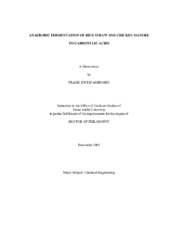| dc.description.abstract | In this work, 80% lime-treated rice straw and 20% lime-treated chicken manure
were used as substrates in rotary fermentors. Countercurrent fermentation was
performed at various volatile solid loading rates (VSLR) and liquid residence times
(LRT). The highest acid productivity of 1.69 g/(L·d) was at a total acid concentration of
32.4 g/L. The highest conversion and yield were 0.692 g VS digested/g VS fed and 0.29
g total acids/g VS fed, respectively. The continuum particle distribution model (CPDM)
was used to predict product concentrations at various VSLR and LRT. CPDM predicted
the experimental total acid concentration and conversion at an average error of 6.41%
and 6.55%, respectively.
A fixed-bed fermentation system was designed to perform pretreatment and
fermentation in the same unit. High product concentrations (~48 g/L) as well as high
conversions (0.741 g VS digested/g VS fed, F4, Train B) were obtained from the same
fermentor. CPDM was extended to predict product concentrations in the fixed-bed
fermentation system. The model gave a good estimate of the product concentrations and
retention time.
After biomass fermentation, the residue can be combusted to generate heat. For
pretreatment purposes, the use of ash can replace lime. A study was performed using
ash as a potential pretreatment agent. Ash from raw poplar wood was effective in
pretreating poplar wood; however, ash from bagasse fermentation residues was not
useful in pretreating bagasse.
Previous modeling studies indicate that a conversion of 95% could be achieved
with bagasse using countercurrent fermentation. Because lignin constitutes 13% of the dry weight of bagasse, this means lignin would have to be digested to obtain a
conversion of 95%. Experiments on the fermentation of enzymatically liberated lignin
from both poplar wood and bagasse do not show that solubilized lignin was fermented
to organic acids by using a mixed culture of marine microorganisms.
Two buffer systems (ammonium bicarbonate and calcium carbonate) were used
to compare product concentrations of carboxylic acid fermentations using office paper
and chicken manure. It has been demonstrated that the total product concentration using
ammonium bicarbonate is almost double the product concentration using calcium
carbonate. | en |


